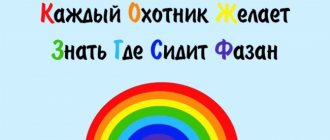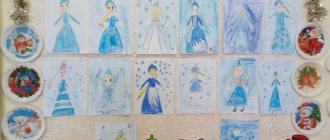Summary of a lesson on methods of speech development in the senior group on the topic “Retelling the fairy tale “The Fox and the Cancer”
Summary of a lesson on methods of speech development
in the senior group on the topic: “Retelling the fairy tale “The Fox and the Cancer” Tasks:
- Teach children to tell the fairy tale “The Fox and the Cancer” coherently, consistently and expressively without the help of questions from the teacher. Lead to compiling a descriptive story based on the painting “Fox with Cubs.”
- Learn to form words with similar meanings.
- Learn to use words with opposite meanings (big-small, strong-weak, fast-slow, etc.)
- Develop the vocal apparatus and articulation: learn to pronounce phrases quietly, loudly, in a whisper.
Equipment:
- Fairy tale "The Fox and the Crayfish";
- Painting of a fox;
- Painting with the image of a fox with fox cubs.
- Fox toy
Progress of the lesson
Children sit on the carpet in a semicircle.
The teacher invites the children to guess the riddle: The tail is fluffy, the fur is golden. Lives in the forest, steals chickens in the village. Children
: Fox
Question to the children:
“Why do you think it’s a fox?”
Children's answers.
— Children, look at the picture of a fox with cubs and answer the questions:
- “Who is pictured here?” (fox and fox cubs, fox with fox cubs, etc.)
- “How can you call a fox cub affectionately?” (little fox, little fox, baby)
- “How can you tell about a little fox, what is he like?” (red, small, tiny - if the children do not answer small, the teacher asks a leading question: is he big or small?).
- “The fox is small, but what kind of fox is it?” (large).
- “The fox is big and strong, but what about the little fox?” (small, weak).
- “That’s right, the little fox is still weak because he’s small, but when he grows up, what will he be like?” (big, strong)
—
“The fox cubs are still small and weak: they don’t know how to hunt, so the mother fox gets them food.
She knows that the foxes are hungry and runs to them. How does she run towards them? (fast). But little foxes don’t know how to run fast. How do they run?” (slowly) The teacher calls 3-4 children and invites them to write a short descriptive story about a fox and a fox cub. —
: “Guys, there are many fairy tales about the fox.
What fairy tales do you know where the fox is the heroine?” Children’s answers:
“The Fox and the Wolf”, “Zayushkina’s Hut”, The Fox and the Wolf”, etc.
-
“Well done, you know a lot of fairy tales about the fox.”
Questions for children:
- “What is the affectionate name for a fox in fairy tales?” (Fox-sister, Foxy, Fox-Patrickievna, Lisyushka)
- “What kind of fox does the author portray in fairy tales?” (cunning, smart, evasive, clever, affectionate, rude, inventor)
- “Can a fox be affectionately called a little fox?” (it is forbidden)
- "And why?" (a fox is a cub)
—
“Guys, listen to a fairy tale called “The Fox and the Crayfish.”
The teacher tells the children a fairy tale without reading it. The fox says to the crayfish: - Let's distill! - Well, fox, come on. They began to distill. The fox ran, and the crayfish grabbed the fox's tail. The fox ran to the spot, turned around to look, wagged its tail, the crab unhooked and said: “I’ve been waiting here for you for a long time.” Questions for children:
- “What did the fox offer to the cancer? How can you say this differently? (we run to the race to see who can come running faster).
- “Why did the fox suggest that the crayfish run?”
- “Why is the fox cunning?”
- “And what kind of cancer is it?” (even more cunning: he guessed to cling to the fox’s tail. Cancer is cunning, cunning, cunning).
Educator
: “Guys, listen to the story again, and then you will tell it yourself.”
The teacher calls three children to him and invites them to tell a fairy tale. One - for cancer; to another - for a fox; the third - for the author. Then he calls the other three children and invites them to do the same. Then one child tells the whole fairy tale, at will, if there are no willing ones, the teacher chooses it. The teacher conducts a physical education lesson. I, the little fox-sister, walked through the forest. I, the little fox-sister, screamed with a voice. I, the little fox-sister, tore the Lapotkas, I, the little fox-sister, weaved the Lapotkas. The teacher continues the lesson. Pictures of a fox are attached to the board. The teacher invites 5-6 children to take turns choosing a picture and coming up with a short story about a fox (tell what it is like). Children's answers:
“I have a red fox, its tail is golden and fluffy.”
“My fox is cunning, its tail is also fluffy, and its eyes are black.” “My fox has an even fluffier tail, she has soft paws, she is smart.” And so on. The teacher breaks down the word fox with the children in parts. The teacher invites the children to say the word fox not immediately, but in parts. If this causes difficulties for them, he gives an example of the following pronunciation: “Listen to how I say the word “li-sa.” Then he calls several children to repeat. Questions for children:
- “How many parts is the word fox divided into?” (for two).
- “What’s the first part?” (li).
- “Which is the second one?” (sa).
The teacher tells the children that parts of a word are called syllables because the word is made up of them. At the end of the lesson, the teacher says a simple saying: “Sasha met a fox in the forest” and invites the children to repeat it with different intonations: loudly, quietly, in a whisper. Summing up the lesson. Questions for children:
“Did you like the lesson?” “What new have you learned?” Children's answers.
Progress of the lesson.
The teacher expressively reads the fairy tale “ The Fox and the Goat ”
Questions: what is this fairy tale about ? how does it start? What kind of fox is shown in the fairy tale ? Why do you think she's cunning? What other fox ? How is the goat shown? Why do you think so? What words and expressions did you like best?
Educator: listen to the fairy tale again , then you will tell . Ask 3-4 children, at the end you can tell a fairy tale by role . Rate.
told the story interestingly and expressively . Who can say what kind of goat he was? And what words can you say ? (Examples of answers: slow-witted, stupid, unintelligent, inattentive)
.
fox was (red, cunning, beautiful, smart, dexterous, fast)
.
Educator: What was the well like (Deep, cold, muddy, dirty)
.
Educator: What can be cold? What can you say “cold” (snow, wind, ice)
Educator: What can you say “cold” (winter, icicle, snowflake)
.
Educator: What can you say “cold” (ice cream, sea, milk)
.
Educator: What can you say
Educator: listen carefully and guess: cold, blue, transparent - is it a river or a stream? Brown, fluffy, fur - is it a hat or a collar? Blue, glass, crystal - a cup or saucer? Teacher: and now we will learn a tongue twister about a fox: “ The fox runs along the bridge , the fox licks the sand . “ (say loudly, quietly, moderately)
Methodological instructions: if children find it difficult to evaluate their peers, the teacher does this himself, paying attention to the conveyance of the content of the fairy tale , the expressiveness of the dialogue using a variety of words and expressions.
Theatrical screening of the fairy tale “The Orphan Fox” Presenter: We will tell you a fairy tale that is not simple, but with a deep meaning: about friendship and trust of animals, mutual assistance, mutual assistance and about deception.
GCD summary for retelling the fairy tale in the preparatory group “The Fox and the Goat” GCD summary for the school preparatory group Topic: Retelling the fairy tale “The Fox and the Goat” Integration of OO: social-communicative, physical.
Synopsis of the open educational activity “Retelling the fairy tale “Khavroshechka”” Synopsis of the open viewing of direct educational activities on “Familiarization with fiction and speech development.”
Summary of a lesson on speech development in the senior group retelling the Russian folk tale The Fox and the Wolf Topic: “Retelling the Russian folk tale “The Fox and the Wolf” Program content: Help children understand the main thing in the character of fairy-tale characters.
Summary of a lesson on speech development in the preparatory group “Retelling the fairy tale “The Fox and the Goat”” Summary of a lesson on speech development in the preparatory group on the topic: “Retelling the fairy tale “The Fox and the Goat”. Tasks: O - consolidate ideas.
Summary of a lesson on speech development in the senior group, retelling the fairy tale “The Fox and the Crayfish” Senior group. ECD for speech development retelling the fairy tale “The Fox and the Cancer” Goal: to teach children to tell stories coherently, consistently and expressively.
Scenario of the Bashkir folk tale “The Fox the Carpenter.” Roles: bear, fox, wolf. Attributes: decoration “Forest”, tree stump, costumes: bear, fox, wolf, building material, tools, barrel.
Source
MAGAZINE Preschooler.RF
Summary of educational activities for speech development retelling the fairy tale “The Fox and the Goat”Author: Pedchenko Anastasia Vladimirovna, Usolye-Sibirskoye
Goal: To create conditions for the formation of children’s ideas about the features of the composition of fairy tales.
Objectives: To form children’s ideas about the features of the composition of fairy tales (beginning, ending); select definitions for nouns denoting objects and phenomena of the surrounding world, find an object based on the named characteristics; when agreeing words, focus on their endings; learn to pronounce tongue twisters clearly and intelligibly with different voice volumes (loud, moderate, quiet, whisper); select words that are similar in sound and rhythm.
Material. Pictures of a fox.
Progress of the lesson:
The teacher asks a riddle: “The tail is fluffy, the fur is golden - who is the riddle about?” (About a fox.) Shows the children several pictures of a fox: “When you were in the older group, you and I looked at different pictures. Now you can take any picture and say what kind of fox you have. If one has a red fox, then another has another... someone has a beautiful fox, and someone else..."
The teacher expressively tells the fairy tale “The Fox and the Goat . Asking questions:
—What is this fairy tale about?
- How does it start? ends?
- How is the fox shown in the fairy tale? Why do you think she's cunning? How else is a fox depicted?
-What kind of goat is in the fairy tale? Why do you think he is like this?
— What words and expressions did you like best?
“Listen to the story again,” the teacher suggests, “then you will tell it.” Listen carefully and remember.
3-4 retellings are heard.
You can invite children to retell the fairy tale in roles (or in a group - “team” ).
Children evaluate their comrades' retellings. If they find it difficult, the teacher does it himself, drawing their attention to the completeness of the content, the expressiveness of intonation in the dialogue, the use of figurative words and expressions from the text.
The teacher addresses the children:
— You told the story interestingly and expressively. Let's think again about what kind of goat he was. What words can you use to describe him? (Slow-witted, stupid, unintelligent, inattentive, etc.)
-What was the fox like? (Red-haired, cunning, beautiful, smart, dexterous, fast, nimble.)
- What words that you said about the goat and the fox can be used when speaking about a person?
- What kind of well was it? (Deep, cold, dark, muddy, dirty, narrow.)
— What else can be called “cold” ? (Snow, ice, air, wind...)
— What can be called “cold” ? (Winter, snowflake, icicle, piece of ice...)
- Listen carefully and answer. Cold, deep, transparent - is it a river or a stream?.. Blue, glass, fragile - is it a saucer or a cup?
When conducting these exercises, the teacher makes sure that the children clearly pronounce endings and correctly agree adjectives with nouns.
The teacher suggests learning a tongue twister about a fox: “The fox runs along the six. Lick the fox, the sand . The teacher and then the children pronounce the tongue twister loudly, moderately, quietly, in a whisper.
You can give the children the task of coming up with a rhyme for the words “Where have you been, little fox?” (Danced on the lawn; rested under a bush, etc.) Everyone repeats the most successful couplet loudly, quietly, in a whisper.
| Next > |
Leave your comment
Gift certificates
Responsibility for resolving any controversial issues regarding the materials themselves and their contents is taken by the users who posted the material on the site. However, the site administration is ready to provide all possible support in resolving any issues related to the work and content of the site. If you notice that materials are being used illegally on this site, please notify the site administration using the feedback form.
All materials posted on the site were created by the authors of the site or posted by users of the site and are presented on the site for informational purposes only. Copyrights for materials belong to their legal authors. Partial or complete copying of site materials without written permission from the site administration is prohibited! The opinion of the administration may not coincide with the point of view of the authors.
Source
NGO "Speech Development"


